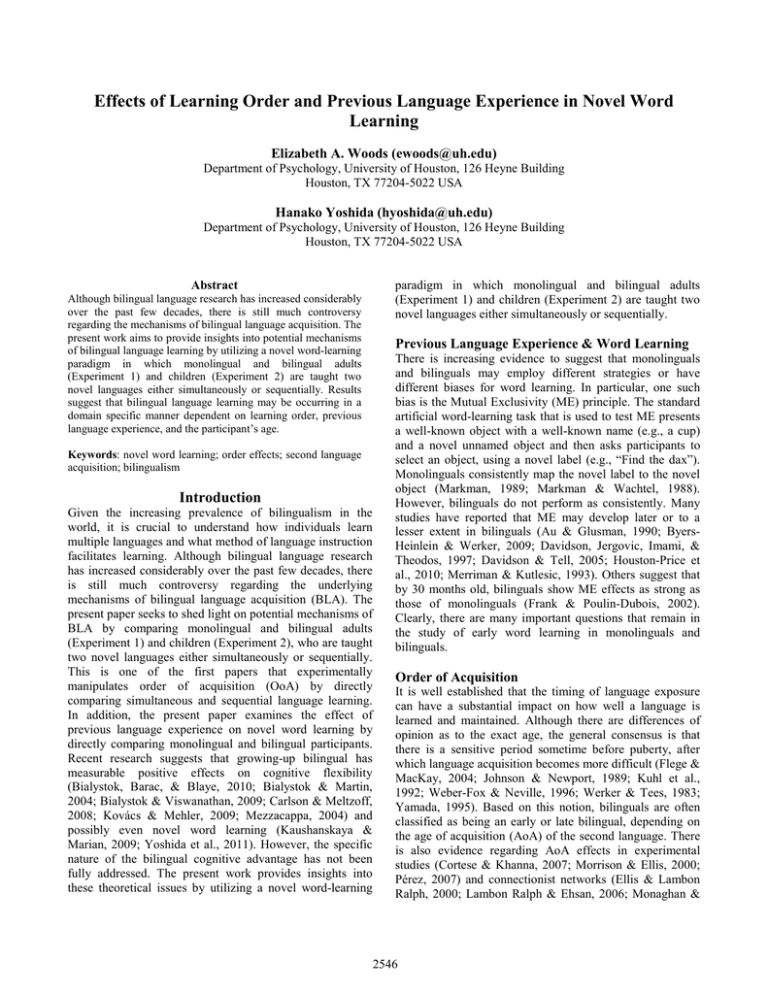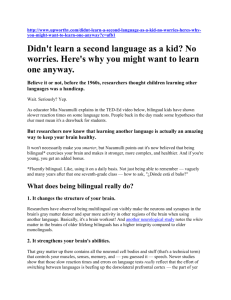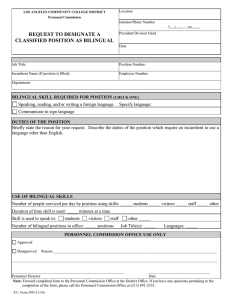Effects of Learning Order and Previous Language Experience in Novel... Learning Elizabeth A. Woods () Hanako Yoshida ()
advertisement

Effects of Learning Order and Previous Language Experience in Novel Word Learning Elizabeth A. Woods (ewoods@uh.edu) Department of Psychology, University of Houston, 126 Heyne Building Houston, TX 77204-5022 USA Hanako Yoshida (hyoshida@uh.edu) Department of Psychology, University of Houston, 126 Heyne Building Houston, TX 77204-5022 USA Abstract paradigm in which monolingual and bilingual adults (Experiment 1) and children (Experiment 2) are taught two novel languages either simultaneously or sequentially. Although bilingual language research has increased considerably over the past few decades, there is still much controversy regarding the mechanisms of bilingual language acquisition. The present work aims to provide insights into potential mechanisms of bilingual language learning by utilizing a novel word-learning paradigm in which monolingual and bilingual adults (Experiment 1) and children (Experiment 2) are taught two novel languages either simultaneously or sequentially. Results suggest that bilingual language learning may be occurring in a domain specific manner dependent on learning order, previous language experience, and the participant’s age. Previous Language Experience & Word Learning Keywords: novel word learning; order effects; second language acquisition; bilingualism Introduction Given the increasing prevalence of bilingualism in the world, it is crucial to understand how individuals learn multiple languages and what method of language instruction facilitates learning. Although bilingual language research has increased considerably over the past few decades, there is still much controversy regarding the underlying mechanisms of bilingual language acquisition (BLA). The present paper seeks to shed light on potential mechanisms of BLA by comparing monolingual and bilingual adults (Experiment 1) and children (Experiment 2), who are taught two novel languages either simultaneously or sequentially. This is one of the first papers that experimentally manipulates order of acquisition (OoA) by directly comparing simultaneous and sequential language learning. In addition, the present paper examines the effect of previous language experience on novel word learning by directly comparing monolingual and bilingual participants. Recent research suggests that growing-up bilingual has measurable positive effects on cognitive flexibility (Bialystok, Barac, & Blaye, 2010; Bialystok & Martin, 2004; Bialystok & Viswanathan, 2009; Carlson & Meltzoff, 2008; Kovács & Mehler, 2009; Mezzacappa, 2004) and possibly even novel word learning (Kaushanskaya & Marian, 2009; Yoshida et al., 2011). However, the specific nature of the bilingual cognitive advantage has not been fully addressed. The present work provides insights into these theoretical issues by utilizing a novel word-learning There is increasing evidence to suggest that monolinguals and bilinguals may employ different strategies or have different biases for word learning. In particular, one such bias is the Mutual Exclusivity (ME) principle. The standard artificial word-learning task that is used to test ME presents a well-known object with a well-known name (e.g., a cup) and a novel unnamed object and then asks participants to select an object, using a novel label (e.g., “Find the dax”). Monolinguals consistently map the novel label to the novel object (Markman, 1989; Markman & Wachtel, 1988). However, bilinguals do not perform as consistently. Many studies have reported that ME may develop later or to a lesser extent in bilinguals (Au & Glusman, 1990; ByersHeinlein & Werker, 2009; Davidson, Jergovic, Imami, & Theodos, 1997; Davidson & Tell, 2005; Houston-Price et al., 2010; Merriman & Kutlesic, 1993). Others suggest that by 30 months old, bilinguals show ME effects as strong as those of monolinguals (Frank & Poulin-Dubois, 2002). Clearly, there are many important questions that remain in the study of early word learning in monolinguals and bilinguals. Order of Acquisition It is well established that the timing of language exposure can have a substantial impact on how well a language is learned and maintained. Although there are differences of opinion as to the exact age, the general consensus is that there is a sensitive period sometime before puberty, after which language acquisition becomes more difficult (Flege & MacKay, 2004; Johnson & Newport, 1989; Kuhl et al., 1992; Weber-Fox & Neville, 1996; Werker & Tees, 1983; Yamada, 1995). Based on this notion, bilinguals are often classified as being an early or late bilingual, depending on the age of acquisition (AoA) of the second language. There is also evidence regarding AoA effects in experimental studies (Cortese & Khanna, 2007; Morrison & Ellis, 2000; Pérez, 2007) and connectionist networks (Ellis & Lambon Ralph, 2000; Lambon Ralph & Ehsan, 2006; Monaghan & 2546 Ellis, 2002) to suggest that early-acquired information is processed faster than later acquired information. Although research regarding AoA and sensitive periods overwhelmingly suggests that learning earlier is better, there is still much controversy regarding the mechanism behind this early advantage. One explanation that has not been given much consideration is that a more basic mechanism such as order of learning may be responsible for this early advantage (Burling & Yoshida, 2011). Recent experimental paradigms have found that early-learned items are retained better than later-learned items, even when difficulty and age and amount of exposure are controlled (Izura et al., 2011; Stewart & Ellis, 2008). This suggests that AoA effects could actually be due to more basic order effects. The present work further examines this possibility of order effects by comparing simultaneous and sequential learning of two novel languages. The bilingual literature readily discusses OoA; bilinguals who acquire both languages from birth are referred to as simultaneous bilinguals and those who learn one language before the other are referred to as sequential bilinguals. Simultaneous and sequential bilingualism are even conceptualized as two different mechanisms – Bilingual First Language Acquisition and Second Language Acquisition respectively (for a review see Genesee & Nicoladis, 2007; Paradis, 2007) – suggesting that simultaneous and sequential language learning are qualitatively different. Although these studies provide an important step towards understanding the different types of bilingualism retrospectively, the majority do not experimentally manipulate simultaneous and sequential dual language learning. In addition, BLA is often confounded by the fact that all simultaneous bilinguals are early bilinguals, and many sequential bilinguals are late bilinguals. Given that early learning is thought to be superior, it is important to compare simultaneous and sequential language learning when both occur early. The present work addresses these difficulties by experimentally testing adults (Experiment 1) and children (Experiment 2) who are in the active process of acquiring two new languages in two different mock bilingual environments. 1a. 1b. Figure 1. Example training trials from the simultaneous condition (a) and sequential condition (b). Figure 2. Sample training design for two word-object pairs in the simultaneous condition (on the top) and the sequential condition (on the bottom) for Experiment 1 and 2. Experiment 1 The purpose of Experiment 1 was to determine how the two factors of order of acquisition (OoA) and previous language experience influence word learning in adults. To accomplish this, we utilized a novel word-learning paradigm that imitated a bilingual environment by exposing monolingual and bilingual adults to two novel languages. Participants were randomly assigned to learn these two novel languages either one after the other (Sequential Condition) or at the same time (Simultaneous Condition). Participants were instructed that they would be learning new words from two friendly aliens that were from different planets and spoke different languages. They were then introduced to the aliens and underwent 16 training trials followed by 16 testing trials. Participants Eighty adults (Mage = 24.06 years, SD = 4.20) were recruited from the University of Houston in Houston, Texas and were asked to fill out a consent form and demographic questionnaire that included questions about their language history. Based on their responses, participants were identified as bilingual or monolingual and were randomly assigned to either the simultaneous or sequential condition. This yielded four groups of adults: Simultaneous Bilingual (N = 21), Simultaneous Monolingual (N = 19), Sequential Bilingual (N = 20), and Sequential Monolingual (N = 20). Consistent with the Houston population, monolinguals were monolingual English speakers, and bilingual participants represented a variety of language groups, including Arabic-English, French-English, German-English, Japanese-English, Malayalam-English, Mandarin-English, Spanish-English, and Vietnamese-English. Similarly, bilinguals included those who learned both languages from birth, both languages early in life but sequentially, and 2547 second language learners who learned their second language long after their first. This allows the results of the present study to be extended to a broader bilingual population. Materials Sixteen novel word-object pairs were created by assigning each of 16 novel words to one of eight novel objects so that each object had two labels – one in each language. Objects were digital photographs of three-dimensional items created in our lab from craft materials; words were selected from a non-word database (Horst, 2009), produced and recorded by a female native English speaker, and presented auditorily to participants. Sounds were intentionally selected to be as similar as possible across the two languages in order to increase experimental control for the particular question of order effects. Words in each language were matched for length and number of syllables. Alien characters were threedimensional digital cartoon figures selected from an online graphics database. Training Sequential Condition Training Phase 1 included 8 training trials, each of which presented a single novel object on the screen paired with an auditory phrase (i.e. “This is a Dax! See the Dax?”). Each trial lasted 5 seconds with both the auditory phrase and the object presented at trial onset, and the object remaining on the screen for the entire trial. This was immediately followed by Training Phase 2, which continued in the same manner, but with a set of 8 new words for the same objects. By the end of these two phases of training, each of the 8 objects had been on the screen for 10 seconds, and each of the 16 words had been heard twice. Simultaneous Condition Training Phase 1 occurred in the same manner as the sequential condition, except that on each training trial the object was paired with two novel names within the same auditory phrase (i.e. “This is a Dax and this is a Mig!”). Training Phase 2 was an exact replication of phase 1 for this condition. By the end of these two phases of training, each of the 8 objects had been on the screen for 10 seconds, and each of the 16 words had been heard twice. Testing Testing included 16 trials, one for each word-object pair presented during training. Each testing trial consisted of a four-choice forced alternative test that instructed the participant to select a particular object (i.e. “Point to the Dax!”). All target and non-target stimuli had been presented during training. Testing trials were randomized so that word-object pairs from phases 1 and 2 were tested intermixed. Participants received positive or negative auditory feedback on each testing trial based on their response. Figure 3. Experiment 1 results of adults’ learning of novel word-object pairs. Results Overall, adults learned approximately half (M = 49.69%, SD = 17.37) of the word-object pairs, and all four groups of adults performed significantly above chance level. See Figure 3 for more details. To determine the influence of order of language acquisition and previous language experience on learning, a fixed effects ANOVA with factors of order (sequential, simultaneous) and language status (monolingual, bilingual) was conducted. Only a main effect of order was found, F (1,76) = 5.95, p = .017, with an advantage for simultaneous learning over sequential learning. No main effect of language status or an interaction of order with language status was found. These findings suggest that regardless of previous language experience, adults learned the languages better when they were presented simultaneously. Experiment 2 Results from Experiment 1 suggest that when two languages are taught simultaneously, adults retain a greater number of words than when taught sequentially. In addition, previous language experience did not influence adults’ performance. However, given that children process and learn information differently from adults (Hudson, Kam, & Newport, 2005; Hudson, Kam, & Newport, 2009; Ramscar et al., 2011), and may use different word learning strategies than adults, this raises the question of how order of acquisition and previous language experience influence word learning in children. To accomplish this, we utilized a shortened version of the novel word-learning paradigm in Experiment 1. Participants Seventy-nine children ages 36 to 72 months (Mage = 51.78 months, SD = 11.9) were recruited from the local communities and preschools in Houston, Texas. Parents completed a consent form and demographic questionnaire that included questions about their child’s language history. Based on their responses, participants were identified as 2548 bilingual or monolingual and were randomly assigned to either the simultaneous or sequential condition. This yielded four groups of children: Simultaneous Bilingual (N = 17), Simultaneous Monolingual (N = 23), Sequential Bilingual (N = 17), and Sequential Monolingual (N = 22). Similar to Experiment 1, bilingual participants represented a variety of language groups and language backgrounds. However, since all participants were 6 years of age or younger, both languages were learned relatively early in life. Materials Stimuli were a subset of the stimuli from Experiment 1 and included 8 novel words and 4 novel objects (each object had two labels – one in each language). Procedure Procedures followed in the same manner as that of Experiment 1, but with a total of 8 training trials instead of 16 and 8 testing trials instead of 16. Results Overall, children learned one-third (M = 33.07%, SD = 16.63) of the word-object pairs, and three of the four groups of children performed significantly above chance level. See Figure 4 for more details. To determine the influence of order of acquisition and previous language experience on learning, a fixed effects ANOVA with factors of order (sequential, simultaneous) and language status (monolingual, bilingual) was conducted. No main effects were found, but an interaction effect of order by language status was found, F (1,75) = 4.40, p = .039. This suggests that the effect of order of acquisition on novel word learning was dependent on previous language experience. Post hoc simple main effects analyses revealed that monolinguals scored significantly higher than bilinguals in the sequential condition, but there were no differences between monolinguals and bilinguals in the simultaneous condition. Figure 4. Experiment 2 results of children’s learning of novel word-object pairs. General Discussion These findings have implications for our understanding of the mechanisms underlying word learning in general, and how those mechanisms might differ in monolinguals and bilinguals, and adults and children. In particular, our results suggest that word learning may be occurring in a domain specific manner dependent on order of learning, previous language experience, and participant’s age. In regards to the effect of order of learning, adults learned a greater percent of the words in the simultaneous condition than in the sequential condition. This is consistent with previous research regarding sensitive periods (Flege & MacKay, 2004; Johnson & Newport, 1989; Kuhl et al., 1992; Weber-Fox & Neville, 1996; Werker & Tees, 1983; Yamada, 1995), AoA effects (Cortese & Khanna, 2007; Ellis & Lambon Ralph, 2000; Lambon Ralph & Ehsan, 2006; Monaghan & Ellis, 2002; Morrison & Ellis, 2000; Pérez, 2007), and OoA effects (Izura et al., 2011; Stewart & Ellis, 2008), all of which suggest that learning information earlier is better. This simultaneous advantage could also potentially be a result of more distributed learning (see Cepeda, et al., 2006) since information in the simultaneous condition was repeated across two training sessions instead of repeated within a single training session. However, the effect of order was different for children. In the case of Experiment 2, learning order interacted with children’s previous language experience. Monolingual children scored significantly higher than bilingual children in the sequential condition, but there were no differences between monolinguals and bilinguals in the simultaneous condition. Learning order still mattered for children, but the ideal type of acquisition was dependent on their previous language experience. The effect of previous language experience also differed in children and adults. Experiment 1 revealed no differences between monolingual and bilingual adults in terms of the percent of words learned. However, in Experiment 2, monolingual children performed better than bilingual children in the sequential condition. These results seem inconsistent with previous research that would suggest a possible bilingual advantage for language learning (Kaushanskaya & Marian, 2009; Yoshida et al., 2011). However, the current work essentially entailed associative learning of word-object pairs, whereas previous studies that have found a bilingual cognitive advantage typically involved attentional shifting or competition resolution. Thus, it may be that any bilingual cognitive advantages are highly task specific, and that the current task did not tap into the cognitive skills for which bilinguals typically show an advantage. Future research should continue to evaluate monolinguals’ and bilinguals’ performance on various types of learning tasks. Given that the effects of learning order and previous language experience had differential effects in adults and children, it may be that different learning mechanisms are driving bilingual language learning in adults and children. 2549 This is consistent with previous research suggesting that adults and children process information in qualitatively different ways (Hudson, Kam, & Newport, 2005; Hudson, Kam, & Newport, 2009; Ramscar et al., 2011). Additional developmental work is needed to determine how and why these learning mechanisms may change across development. The present work highlights the potential importance of order in learning and the differential effects that it may have for language learning in monolinguals and bilinguals, as well as in adults and children. As seen here, bilingual language learning may be highly dependent on the specific type of learning environment as well as other factors that were not directly addressed in the present work, such as the relationship between the two languages and the individual’s specific linguistic background (Bialystok, McBride-Chang, & Luk, 2005; Cummins, 1979; Müller, 1998; Müller & Hulk, 2001). Although the current stimuli were designed to be similar across languages for purposes of experimental control, this is not akin to a natural language learning environment in which languages are phonologically distinct from one another. Bilingual children in particular may be highly sensitive to such linguistic cues given their experience with these cues signaling which language is being used. These matters merit further investigation to advance general learning theories as well as theories of bilingual language acquisition. Acknowledgments This research was supported in part by a National Institutes of Health grant (R01 HD058620), the Foundation for Child Development, and the University of Houston’s Grants to Enhance and Advance Research (GEAR) program. We thank the children and parents who participated in this study. References Au, T. K., & Glusman, M. (1990). The principle of mutual exclusivity in word learning: To honor or not to honor? Child development, 61, 1474–1490. Bialystok, E., Barac, R., & Blaye, A. (2010). Word mapping and executive functioning in young monolingual and bilingual children. Journal of Cognition and Development, 11(4), 485-508. Bialystok, E., & Martin, M. M. (2004). Attention and inhibition in bilingual children: Evidence from the dimensional change card sort task. Developmental Science, 7, 325-339. Bialystok, E., McBride-Chang, C., & Luk, G. (2005). Bilingualism, language proficiency, and learning to read in two writing systems. Journal of Educational Psychology, 97 (4), 580-590. Bialystok, E., & Viswanathan, M. (2009). Components of executive control with advantages for bilingual children in two cultures. Cognition, 112, 494–500. Burling, J., & Yoshida, H. (2011). A Developmental Perspective on Order and Learning: Temporal Effects on Cued Attention. In L. Carlson, C. Hölscher, & T. Shipley (Eds.), Proceedings of the 33rd Annual Conference of the Cognitive Science Society (pp. 2937-2942). Austin, TX: Cognitive Science Society. Byers-Heinlein, K., & Werker, J. F. (2009). Monolingual, bilingual, trilingual: Infants’ language experience influences the development of a word learning heuristic. Developmental Science, 12(5), 815-823. Carlson, S. M. & Meltzoff, A. N. (2008). Bilingual experience and executive functioning in young children. Developmental Science, 11(2), 282–298. Cepeda, N. J., Pashler, H., Vul, E., Wixted, J., & Rohrer, D. (2006). Distributed practice in verbal recall tasks: A review and quantitative synthesis. Psychological Bulletin, 132, 354-380 Cortese, M. J., & Khanna, M. M. (2007). Age of acquisition predicts naming and lexical-decision performance above and beyond 22 other predictor variables: An analysis of 2, 342 words. Quarterly Journal of Experimental Psychology, 60, 1072–1082. Cummins, J. (1979). Linguistic interdependence and the educational development of bilingual children. Review of Educational Research, 49, 222-251. Davidson, D., Jergovic, D., Imami, Z., & Theodos, V. (1997). Monolingual and bilingual children's use of the mutual exclusivity constraint. Journal of Child Language, 24, 3–24. Davidson, D. & Tell, D. (2005). Monolingual and bilingual children’s use of mutual exclusivity in the naming of whole objects. Journal of Experimental Child Psychology, 92, 25–45. Ellis, A. W., & Lambon Ralph, M. (2000). Age of acquisition effects in adult lexical processing reflect loss of plasticity in maturing systems: Insights from connectionist networks. Journal of Experimental Psychology: Learning, Memory, and Cognition, 26, 1103–1123. Flege, J. E., and MacKay, I. R. A. (2004). Perceiving vowels in a second language,. Studies of Second Language Acquisition, 26, 1–34. Frank, I., & Poulin-Dubois, D. (2002). Young monolingual and bilingual children’s responses to violation of the Mutual Exclusivity Principle. International Journal of Bilingualism, 6(2), 125-146. Genesee, F., & Nicoladis, E. (2007). Bilingual acquisition. In E. Hoff & M. Shatz (eds.), Handbook of Language Development, 324-342. Oxford, Eng.: Blackwell. Houston-Price, C., Caloghiris, Z., & Raviglione, E. (2010). Language experience shapes the development of the mutual exclusivity bias. Infancy, 15(2), 125-150. Hudson Kam, C. L. & Newport E. L. (2005). Regularizing unpredictable variation: The roles of adult and child learners in language formation and change. Language 2550 Learning and Development, 1, 151-195. Hudson Kam, C. L., & Newport, E. L. (2009). Getting it right by getting it wrong: When learners change languages. Cognitive Psychology, 59, 30-66. Izura, C., Pérez, M., Agallou, E., Wright, V. C., Marín, J., Stadthagen-González, H., & Ellis, A. W. (2011). Age/order of acquisition effects and the cumulative learning of foreign words: A word training study. Journal of Memory and Language, 64, 32-58. Johnson, J. S., & Newport, E. L. (1989). Critical period effects in second language learning: The influence of maturational state on the acquisition of English as a second language. Cognitive Psychology, 21, 60-99. Kaushanskaya, M., & Marian, V. (2009). The bilingual advantage in novel word learning. Psychonomic Bulletin & Review, 16, 705-710. Kuhl, P. K., Williams, K. A., Lacerda, F., Stevens, K. N., and Lindblom, B. (1992). Linguistic experience alters phonetic perception in infants by 6 months of age. Science, 255, 606–608. Kovács, Á. M., & Mehler, J. (2009). Cognitive gains in 7month-old bilingual infants. Proceedings of the National Academy of Sciences of the United States of America, 106, 6556–6560. Lambon Ralph, M. A., & Ehsan, S. (2006). Age of acquisition effects depend on the mapping between representations and the frequency of occurrence: Empirical and computational evidence. Visual Cognition, 13, 928–948. Markman, E. M. (1989). Categorization and Naming in Children: Problems of Induction. MIT Press. Markman, E. M. & Wachtel, G. F. (1988). Children's use of mutual exclusivity to constrain the meanings of words. Cognitive Psychology, 20, 121–157 Merriman, W. E. & Kutlesic, V. (1993). Bilingual and monolingual children’s use of two lexical acquisition heuristics. Applied Psycholinguistics, 14, 229–249. Mezzacappa, E. (2004). Alerting, orienting, and executive attention: Developmental properties and sociodemographic correlates in an epidemiological sample of young, urban children. Child Development, 75, 1373–1386. Monaghan, J., & Ellis, A. W. (2002). What, exactly, interacts with spelling sound consistency in word naming? Journal of Experimental Psychology: Learning, Memory, and Cognition, 28, 183–206. Morrison, C. M., & Ellis, A. W. (2000). Real age of acquisition effects in word naming and lexical decision. British Journal of Psychology, 91, 167–180. Müller, N. (1998). Transfer in Bilingual First Language Acquisition. Bilingualism: Language and Cognition, 1 (3), 151-171. Müller, N. & Hulk, A. (2001). Crosslinguistic Influence in Bilingual Language Acquisition: Italian and French as Recipient Languages. Bilingualism: Language and Cognition, 4 (1), 1-21. Paradis, J. (2007). Second language acquisition in childhood. In E. Hoff and M. Shatz (Eds.), Handbook of Language Development (pp. 387-406). Oxford: Blackwell. Pérez, M. A. (2007). Age of acquisition persists as the main factor in picture naming when cumulative word frequency and frequency trajectory are controlled. The Quarterly Journal of Experimental Psychology, 60, 32–42. Ramscar, M., Dye, M., Klein, J., Ruiz, L.D., Aguirre, N. & Sadaat, L. (2011). Informativity versus logic: Children and adults take different approaches to word learning. In L. Carlson, C. Hoelscher, & T.F. Shipley (Eds.), Proceedings of the 33rd Annual Conference of the Cognitive Science Society (pp. 3326-3331). Austin, TX: Cognitive Science Society. Stewart, N., & Ellis, A. W. (2008). Order of acquisition in learning perceptual categories: A laboratory analogue of the age of acquisition effect? Psychonomic Bulletin & Review, 15(1), 70-74. Weber-Fox, C. M., & Neville, H. J. (1996). Maturational constraints on functional specializations for language processing: ERP and behavioral evidence in bilingual speakers. Journal of Cognitive Neuroscience, 8, 231–256. Werker, J. F., & Tees, R. C. (1983). Developmental changes across childhood in the perception of normative speech sounds. Canadian Journal of Psychology, 37, 278-286. Yamada, R. A. (1995). Age and acquisition of second language speech sounds. Perception of American English /r/ and /l/ by native speakers of Japanese. In Speech Perception and Linguistic Experience: Issues in Crosslanguage Research. W. Strange York, Timonium, MD, pp. 305–320. Yoshida, H., Tran, D. N., Benitez, V., & Kuwabara, M. (2011). Inhibition and Adjective Learning in Bilingual and Monolingual Children. Frontiers in Developmental Psychology, 2:210. 2551




